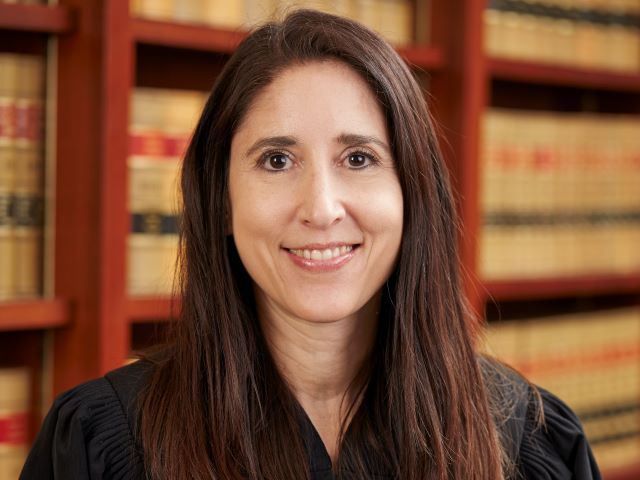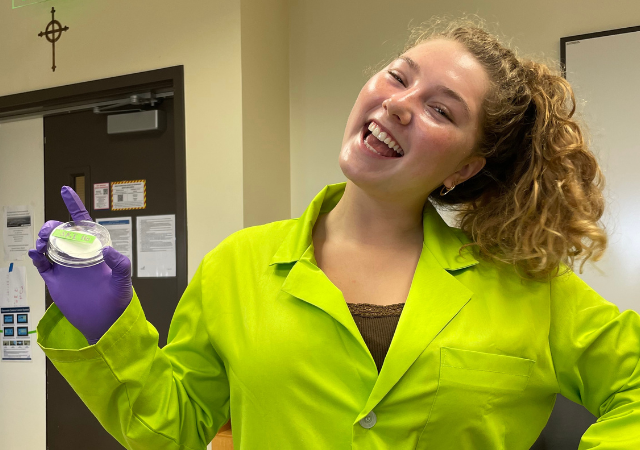Students Engineer Published Study on Classmates' Creativity
From Inside USD -- When Stephanie Harrison attended an engineering conference to present a research poster last June in Las Vegas, some may have wondered, upon first glance, if she was in the right place. That’s because the topic she represented, one she’s been working on since freshman year with six other Shiley-Marcos School of Engineering students and input from three professors, seemed a foregone conclusion.
“I think most people were surprised to see an engineering project about creativity,” recalled Harrison, a junior electrical engineering major at the University of San Diego. “A lot of the other projects were very technical, but that was cool. Ours was a non-technical one that looked at this side of engineering. When people stopped to see my poster and I talked to them about it, they were really interested to hear what engineering students perceived the role of creativity to be.”
Since that conference appearance, others have gravitated toward it. It started as a class project that Honors Program freshman engineering students were assigned by Mechanical Engineering Professor Frank Jacobitz to do with Spring 2012 Introduction to Engineering Design 102 freshman students as the test subjects. Today, the research study on creativity by Harrison, Will Dow, Kathleen McGuire, Philipp Storch, Jessica Urbano, Alyssa Black and Adam Krebs, is a published paper.
The report titled, “Free Your Mind: Unlocking Your Inner Creativity,” appeared in the October 2013 International Journal of Innovative Technology and Creative Engineering. The students, along with Jacobitz and assistance from fellow professors Bradley Chase (Industrial and Systems Engineering) and Thomas Schubert (Electrical Engineering), now have something tangible for their work.
“It’s amazing to know that we began this project as freshmen in college,” said Dow, a junior electrical engineering major. “A lot of students don’t do that until they’re grad students. I’m excited that we could take it from the ground up, but I never dreamed it would end up where it has and that we’d learn all that we’ve learned.”
Jacobitz said the students deserve the credit. “It was written by the students, they are the main authors. Typically in undergraduate research there’s joint ownership, but in this case, that component was shifted to the students. They were made the owners of the project and they had the motivation to do it. That wasn’t something I knew at the beginning, but this wasn’t the usual group doing undergraduate research. This is something that’s normally done by juniors and seniors.”
Creative Process
The abstract for the published article opens with what seems to be a known fact: “Creativity is a major factor in many careers, subjects, and disciplines. Although many people first assume engineering to be a field of study that does not require any creativity, it is actually an essential tool for successful engineers. The mark of a truly accomplished engineer is the ability to problem-solve effectively; in other words, to generate creative solutions.”
Jacobitz wanted all freshmen students —researchers and test subjects — to actively be thinking about creativity.
“I don’t think every engineering student thinks about creativity immediately. If you look at how engineering is taught, it’s often an analysis; the problem is already defined and you apply tools you’ve learned, almost in a mechanical way, so you don’t necessarily think about bringing creativity into that kind of approach to engineering,” Jacobitz said.
Student researchers sought to understand and teach the class the importance of creativity. They first needed to go through the process of the Institutional Review Board’s required certification approval process to do research on humans. They read and studied other creativity studies, even delving into neuroscience aspects. Lecture presentations and pre- and post-lecture surveys were formulated to find out what students already knew about creativity, how they’d rate their creativity on a scale of one to 10 (one being not creative, 10 being highly creative) and more. The post-lecture survey gave the researchers insight into how much information the students retained.
“We talked about creativity versus intelligence, creativity versus academic and professional success and, ultimately, some methods to employ creativity in solving problems,” Dow said.
Questions posed to students in both surveys were: “Do you consider yourself a creative person?” “Do you consider creativity necessary for solving engineering problems?” and “Have creative approaches been successful for you in any problems that you’ve been presented with?” Questions for the post-lecture survey included, “What are various characteristics that you would use to describe a creative person?” and “What do you think is the best way to enhance creativity in group settings?”
The survey netted 67 sets of results. Research students employed a Wilcoxon Signed Ranks Test because they had two populations of nonparametric data and it could compare the two data sets to determine if there was a significant statistical change in distribution between them.
Results, Takeaways
The data showed that the researchers’ presentation definitively altered the students’ perspective on the importance of creativity in engineering and that creativity can be useful in nearly every aspect career and lives.
Though most results went as expected, there was one surprise.
“We saw a lot of people saying, ‘Oh my gosh, there’s a lot of creativity I didn’t know,’ and thinking they have a lot to improve on,” Dow said. “But I think that’s a constant trend. I think all engineers always try to improve themselves so much that they’ll never give themselves a higher rating for something because they recognize there’s so much more to learn.”
Jacobitz was pleased with the process and felt the project helped the student researchers as much as the students who were surveyed. Dow and Harrison each said they took away something from the exercise.
“As we went through this project, the idea I had in my mind about forming this presentation was recognizing the unwarranted assumptions we make in approaching our engineering problems every day,” Dow said.
He began his presentation to students with simple brainteasers to get them in the right mindset. But one presenter, Dow recalled, showed students a skateboard and then asked the students what else could be made from the skateboard’s parts.
“When they came up with more than 100 different things, it was impressive to see the students once they warmed up to it,” he said.
Harrison liked being reminded that creativity has no boundaries.
“One of the biggest points was bringing together different backgrounds,” she said. “The assumption would be that if you’re solving an engineering problem you wouldn’t need to look at biological techniques or something, but being creative is being able to bring together a variety of ideas to solve a problem as opposed to keeping them separate.”
— Ryan T. Blystone
Contact:
School of Engineering
usdengr@sandiego.edu
(619) 260-4627



